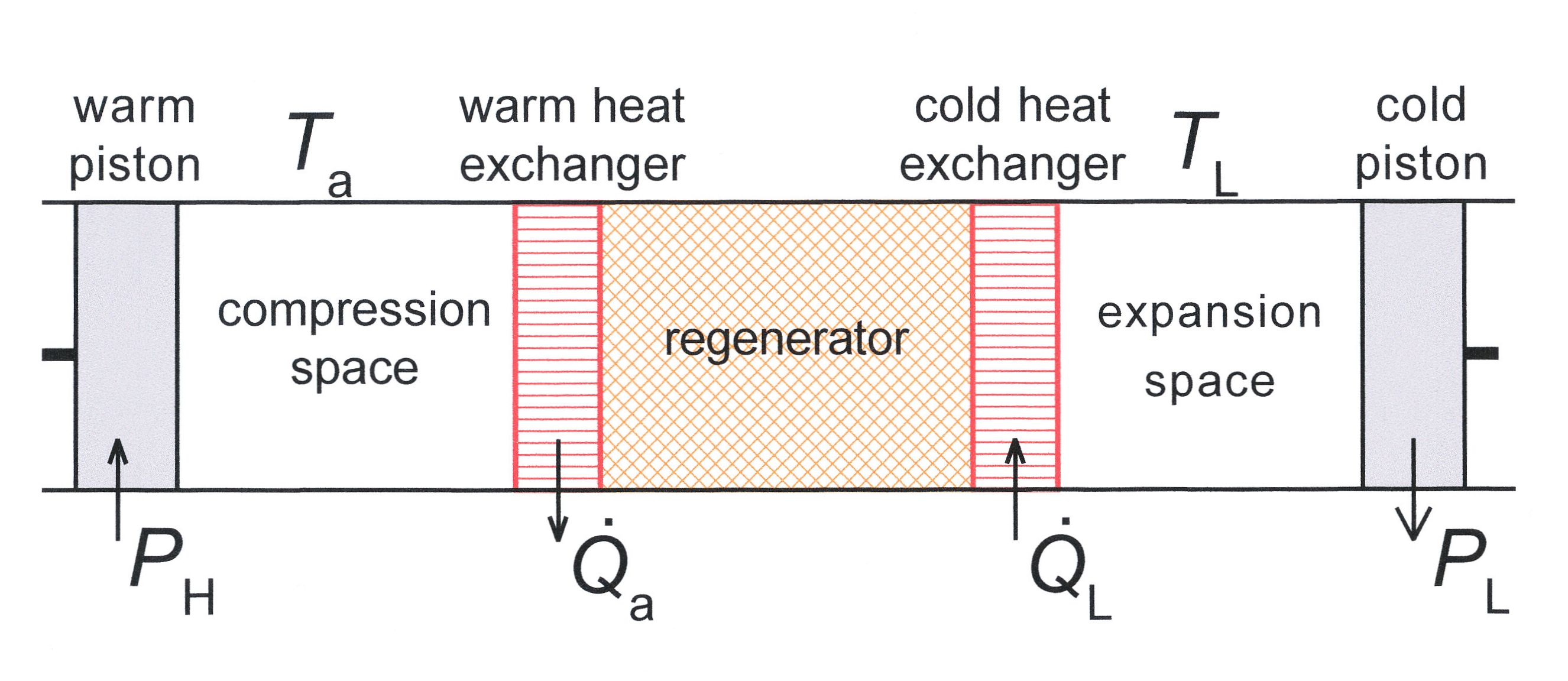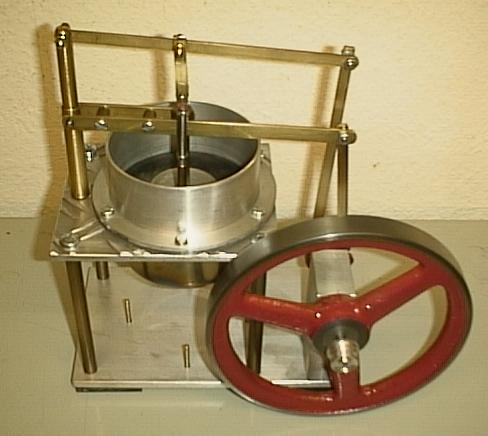|
Cryocooler
A refrigerator designed to reach cryogenic temperatures (below ) is often called a cryocooler. The term is most often used for smaller systems, typically table-top size, with input powers less than about 20 kW. Some can have input powers as low as 2–3 W. Large systems, such as those used for cooling the superconducting magnets in particle accelerators are more often called cryogenic refrigerators. Their input powers can be as high as 1 MW. In most cases cryocoolers use a cryogenic fluid as the working substance and employ moving parts to cycle the fluid around a thermodynamic cycle. The fluid is typically compressed at room temperature, precooled in a heat exchanger, then expanded at some low temperature. The returning low-pressure fluid passes through the heat exchanger to precool the high-pressure fluid before entering the compressor intake. The cycle is then repeated. __TOC__ Ideal heat exchangers and regenerators Heat exchangers are important components of all cry ... [...More Info...] [...Related Items...] OR: [Wikipedia] [Google] [Baidu] |
Pulse Tube Refrigerator
The pulse tube refrigerator (PTR) or pulse tube cryocooler is a developing technology that emerged largely in the early 1980s with a series of other innovations in the broader field of thermoacoustics. In contrast with other cryocoolers (e.g. Stirling cryocooler and GM-refrigerators), this cryocooler can be made without moving parts in the low temperature part of the device, making the cooler suitable for a wide variety of applications. Uses Pulse tube cryocoolers are used in industrial applications such as semiconductor fabrication and in military applications such as for the cooling of infrared sensors. Pulse tubes are also being developed for cooling of astronomical detectors where liquid cryogens are typically used, such as the Atacama Cosmology Telescope or the Qubic experiment (an interferometer for cosmology studies). PTRs are used as precoolers of dilution refrigerators. Pulse tubes are particularly useful in space-based telescopes such as the James Webb Space Telesco ... [...More Info...] [...Related Items...] OR: [Wikipedia] [Google] [Baidu] |
Cryogenic
In physics, cryogenics is the production and behaviour of materials at very low temperatures. The 13th IIR International Congress of Refrigeration (held in Washington DC in 1971) endorsed a universal definition of “cryogenics” and “cryogenic” by accepting a threshold of 120 K (or –153 °C) to distinguish these terms from the conventional refrigeration. This is a logical dividing line, since the normal boiling points of the so-called permanent gases (such as helium, hydrogen, neon, nitrogen, oxygen, and normal air) lie below 120K while the Freon refrigerants, hydrocarbons, and other common refrigerants have boiling points above 120K. The U.S. National Institute of Standards and Technology considers the field of cryogenics as that involving temperatures below -153 Celsius (120K; -243.4 Fahrenheit) Discovery of superconducting materials with critical temperatures significantly above the boiling point of nitrogen has provided new interest in reliable, low cost m ... [...More Info...] [...Related Items...] OR: [Wikipedia] [Google] [Baidu] |
Cryogenic Processor
{{Tone, date=January 2017 A Cryogenic processor is a unit designed to reach ultra-low temperatures (usually around −300 °F / −150 °C) at a slow rate in order to prevent thermal shock to the components being treated. The first commercial unit was developed by Ed Busch in the late 1960s.Koucky, John. "Material Benefits." ''Gear Solutions'' May 2003: 14-23. The development of programmable microprocessor controls allowed the machines to follow temperature profiles that greatly increased the effectiveness of the process. Some manufacturers make cryoprocessors with home computers to define the temperature profile. Before programmable controls were added to control cryogenic processors, the "treatment" process of an object was previously done manually by immersing the object in liquid nitrogen. This normally caused thermal shock to occur within an object, resulting in cracks to the structure. Modern cryogenic processors measure changes in temperature and adjust the input o ... [...More Info...] [...Related Items...] OR: [Wikipedia] [Google] [Baidu] |
Dilution Refrigerator
A 3He/4He dilution refrigerator is a cryogenic device that provides continuous cooling to temperatures as low as 2 mK, with no moving parts in the low-temperature region. The cooling power is provided by the heat of mixing of the Helium-3 and Helium-4 isotopes. The dilution refrigerator was first proposed by Heinz London in the early 1950s, and was experimentally realized in 1964 in the Kamerlingh Onnes Laboratorium at Leiden University. The field of dilution refrigeration is reviewed by Zu et al. Theory of operation The refrigeration process uses a mixture of two isotopes of helium: helium-3 and helium-4. When cooled below approximately 870 millikelvins, the mixture undergoes spontaneous phase separation to form a 3He-rich phase (the concentrated phase) and a 3He-poor phase (the dilute phase). As shown in the phase diagram, at very low temperatures the concentrated phase is essentially pure 3He, while the dilute phase contains about 6.6% 3He and 93.4% 4He. The ... [...More Info...] [...Related Items...] OR: [Wikipedia] [Google] [Baidu] |
Cryogenics
In physics, cryogenics is the production and behaviour of materials at very low temperatures. The 13th IIR International Congress of Refrigeration (held in Washington DC in 1971) endorsed a universal definition of “cryogenics” and “cryogenic” by accepting a threshold of 120 K (or –153 °C) to distinguish these terms from the conventional refrigeration. This is a logical dividing line, since the normal boiling points of the so-called permanent gases (such as helium, hydrogen, neon, nitrogen, oxygen, and normal air) lie below 120K while the Freon refrigerants, hydrocarbons, and other common refrigerants have boiling points above 120K. The U.S. National Institute of Standards and Technology considers the field of cryogenics as that involving temperatures below -153 Celsius (120K; -243.4 Fahrenheit) Discovery of superconducting materials with critical temperatures significantly above the boiling point of nitrogen has provided new interest in reliable, low cost me ... [...More Info...] [...Related Items...] OR: [Wikipedia] [Google] [Baidu] |
Helium
Helium (from el, ἥλιος, helios, lit=sun) is a chemical element with the symbol He and atomic number 2. It is a colorless, odorless, tasteless, non-toxic, inert, monatomic gas and the first in the noble gas group in the periodic table. Its boiling and melting point are the lowest among all the elements. It is the second lightest and second most abundant element in the observable universe (hydrogen is the lightest and most abundant). It is present at about 24% of the total elemental mass, which is more than 12 times the mass of all the heavier elements combined. Its abundance is similar to this in both the Sun and in Jupiter, due to the very high nuclear binding energy (per nucleon) of helium-4, with respect to the next three elements after helium. This helium-4 binding energy also accounts for why it is a product of both nuclear fusion and radioactive decay. The most common isotope of helium in the universe is helium-4, the vast majority of which was formed during t ... [...More Info...] [...Related Items...] OR: [Wikipedia] [Google] [Baidu] |
SNSPD
The superconducting nanowire single-photon detector (SNSPD or SSPD) is a type of light, optical and near-infrared single-photon Photon-counting detector, detector based on a biasing, current-biased superconductivity, superconducting nanowire. It was first developed by scientists at Moscow State Pedagogical University and at the University of Rochester in 2001. The first fully operational prototype was demonstrated in 2005 by the National Institute of Standards and Technology (Boulder), and BBN Technologies as part of the DARPA Quantum Network. As of 2021, a superconducting Niobium nanowire, nanowire single-photon detector is the fastest single-photon detector (SPD) for photon counting. It is a key enabling technology for quantum optics and optical Quantum technology, quantum technologies. SNSPDs are available with very high detection efficiency, very low dark count rate and very low timing jitter, compared to other types of single-photon detectors. As of 2021, commercial SNSPD de ... [...More Info...] [...Related Items...] OR: [Wikipedia] [Google] [Baidu] |
Cooling Technology
Cooling is removal of heat, usually resulting in a lower temperature and/or phase change. Temperature lowering achieved by any other means may also be called cooling.ASHRAE Terminology, https://www.ashrae.org/technical-resources/free-resources/ashrae-terminology The transfer of thermal energy may occur via thermal radiation, heat conduction or convection. Examples can be as simple as reducing temperature of a coffee. Devices * Coolant * Cooling towers, as used in large industrial plants and power stations * Daytime passive radiative cooler * Evaporative cooler * Heat exchanger * Heat pipe *Heat sink *HVAC (Heating, Ventilation and Air Conditioning) * Intercooler * Radiative cooling in Heat shields * Radiators in automobiles *Pumpable ice technology Pumpable ice technology (PIT) uses thin liquids, with the cooling capacity of ice. Pumpable ice is typically a slurry of ice crystals or particles ranging from 5 micrometers to 1 cm in diameter and transported in brine, sea ... [...More Info...] [...Related Items...] OR: [Wikipedia] [Google] [Baidu] |
Entropy Production
Entropy production (or generation) is the amount of entropy which is produced in any irreversible processes such as heat and mass transfer processes including motion of bodies, heat exchange, fluid flow, substances expanding or mixing, anelastic deformation of solids, and any irreversible thermodynamic cycle, including thermal machines such as power plants, heat engines, refrigerators, heat pumps, and air conditioners. In the dual representation entropy– exergy for accounting the second law of thermodynamics it can be expressed in equivalent terms of exergy disruption. Short history Entropy is produced in irreversible processes. The importance of avoiding irreversible processes (hence reducing the entropy production) was recognized as early as 1824 by Carnot. In 1865 Rudolf Clausius expanded his previous work from 1854 on the concept of "unkompensierte Verwandlungen" (uncompensated transformations), which, in our modern nomenclature, would be called the entropy produ ... [...More Info...] [...Related Items...] OR: [Wikipedia] [Google] [Baidu] |
Stirling Engine
A Stirling engine is a heat engine that is operated by the cyclic compression and expansion of air or other gas (the '' working fluid'') between different temperatures, resulting in a net conversion of heat energy to mechanical work. More specifically, the Stirling engine is a closed-cycle regenerative heat engine with a permanent gaseous working fluid. ''Closed-cycle'', in this context, means a thermodynamic system in which the working fluid is permanently contained within the system, and ''regenerative'' describes the use of a specific type of internal heat exchanger and thermal store, known as the ''regenerator''. Strictly speaking, the inclusion of the regenerator is what differentiates a Stirling engine from other closed-cycle hot air engines. In the Stirling engine, a gas is heated and expanded by energy supplied from outside the engine's interior space (cylinder). It is then shunted to a different location within the engine, where it is cooled and compressed. A pisto ... [...More Info...] [...Related Items...] OR: [Wikipedia] [Google] [Baidu] |
Schematic Stirling Cooler
A schematic, or schematic diagram, is a designed representation of the elements of a system using abstract, graphic symbols rather than realistic pictures. A schematic usually omits all details that are not relevant to the key information the schematic is intended to convey, and may include oversimplified elements in order to make this essential meaning easier to grasp, as well as additional organization of the information. For example, a subway map intended for passengers may represent a subway station with a dot. The dot is not intended to resemble the actual station at all but aims to give the viewer information without unnecessary visual clutter. A schematic diagram of a chemical process uses symbols in place of detailed representations of the vessels, piping, valves, pumps, and other equipment that compose the system, thus emphasizing the functions of the individual elements and the interconnections among them and suppresses their physical details. In an electronic circuit ... [...More Info...] [...Related Items...] OR: [Wikipedia] [Google] [Baidu] |








